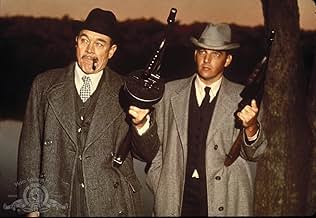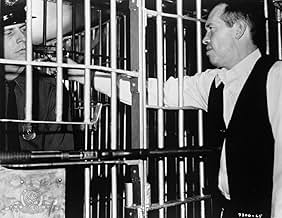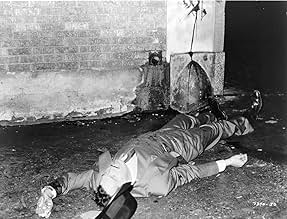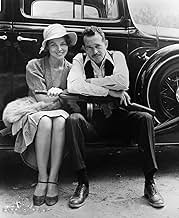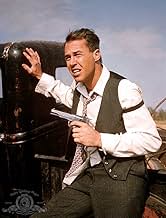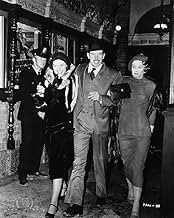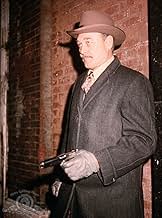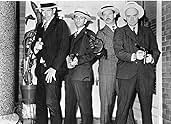PUNTUACIÓN EN IMDb
6,9/10
6,3 mil
TU PUNTUACIÓN
John Dillinger y su pandilla se embarcan en una juerga de robos de bancos por el medio oeste, pero un G-Man está decidido a derribarlo.John Dillinger y su pandilla se embarcan en una juerga de robos de bancos por el medio oeste, pero un G-Man está decidido a derribarlo.John Dillinger y su pandilla se embarcan en una juerga de robos de bancos por el medio oeste, pero un G-Man está decidido a derribarlo.
- Premios
- 1 nominación en total
John P. Ryan
- Charles Mackley
- (as John Ryan)
Jules Brenner
- Wilbur Underhill
- (sin acreditar)
David Dorr
- Leroy
- (sin acreditar)
Roland Bob Harris
- Ed Fulton
- (sin acreditar)
George O. Heath
- John Dillinger, Sr.
- (sin acreditar)
Reseñas destacadas
I watched this for the first time in years after picking up the Widescreen DVD in the bargain bin. As a youngster, I remember many of these films for the bloodletting. How we used to talk them up afterwards. Often I'm disappointed after watching it many years later. 'Hey, that's not how I remember it. Well, 'Dillinger' isn't one of those films. This is a fine film, in fact, it's probably the number 2 film, behind 'Bonnie And Clyde' from that time that portrayed the Depression Era robbers. Warren Oates is excellent. He didn't get the chance very often to play the lead, but this was an excellent chance for him to bust out a little. And there are lots of recognizable actors in smaller roles. But this is Warren nearing his peak. It's as exciting as I remember, actually better then I remember. Well paced with a couple of slower interludes, that towards the end are kind of framed together. If you get a chance watch this film. You'll be pleasantly surprised. Oh and this DVD has the original 'We're In The Money' opening credits, plus it has the diclaimer at the end after the feature is over. I gave it a 7 out of 10.
John Dillinger (Warren Oates) and his gang go on a bank robbing spree across the Midwest, but one G-Man (Ben Johnson) is determined to bring him down.
Following "Bonnie and Clyde" and "The Wild Bunch", American International Pictures wanted their own violent gangster film. Producer Sam Arkoff hired the then-unknown writer John Milius to construct the script. An earlier, very rough version of the script had come in to producer Lawrence Gordon, and Gordon thought Milius – his former assistant -- would be right for the job.
A little research and a solid script would make this an excellent story, but those involved went one step better. Retired FBI Agent Clarence O. Hurt (1897-1975), one of the agents involved in the final shootout with Dillinger, was the film's technical adviser. Hurt had a distinguished career in the gangster era, also being one of the men who brought in Alvin "Creepy" Karpis. Interestingly, Hurt's house was burgled during his funeral – the newspapers liked to say this was the underworld's belated revenge.
In order to save money (Arkoff was always cutting corners), Milius was also offered the director's chair so that AIP would only have to pay one man rather than two. Gordon says this was his idea, but either way the reason was the same. Milius used John Ford as his inspiration, and if you pay close attention you will see homages to Ford's "My Darling Clementine".
The casting of Oates was pure perfection. Although many actors have portrayed John Dillinger before and since, Oates actually resembles the man for the most part. Singer Michelle Phillips as Billie Frechette, Dillinger's girlfriend, came about by an old Hollywood trick: lying. Phillips had told the producers she was half Indian to land her first acting gig.
Arkoff wrote in his autobiography of the ways they saved money on this one; besides the use of Milius, AIP was also selling off the cars after the shoot. So any money they may have spent during filming was in some way regained, even before the first frame hit the movie screens! The script's attention to facts is impressive. Sure, there are some liberties with Melvin Purvis, having him personally strike down more gangsters than he did. And the Little Bohemia Lodge has a few more casualties than it should have, not to mention some guests who weren't really there. By and large, the changes are minor and can easily be dismissed as a way to make the story simpler and more exciting. Having one FBI agent as the hero rather than a dozen is easily to plot out. At least the plot was not a complete fabrication like "Bonnie and Clyde" was; and still, that film is the one that gets more credit.
Upon release, it was inevitable that "Dillinger" would be compared to other gangster films, especially the identically-named "Dillinger" (1945). Dejan Ognjanovic calls Milius' film "the definitive version of the Dillinger story", and he is right. Ognjanovic also rightly notes that Milius paints his characters as mythical beings, larger than life, though the line between good and evil is often blurry. Carlos Clarens wrote that Milius' version "was considerably more romantic" than the 1945 film, despite the "carefully rigged bullet wounds and spurting blood." If nothing else, "Dillinger" deserves some recognition for its role in history: giving John Milius his directorial debut. AIP, especially through Sam Arkoff and Roger Corman, had given rise to numerous filmmakers from Jonathan Demme to Jack Nicholson to James Cameron. Milius may be lesser-known outside of cinephile circles, but his movies are larger than life: "Apocalypse Now", "Red Dawn" and the under-appreciated "Big Wednesday". Lawrence Gordon's career also took off at this point; his cost-cutting measures landed him a gig at 20th Century Fox, where hewent on to specialize in action films such as "Die Hard" and "Predator".
Arrow Video's 2016 blu-ray release gives this film the royal treatment. We have audio commentary by Stephen Prince, the author of "Savage Cinema" and "Screening Violence" (among others), who is an expert on both the violent film genres and gangster history. We also have brand new interviews with producer Lawrence Gordon, director of photography Jules Brenner, and composer Barry De Vorzon. Not enough? There is also a collector s booklet containing new writing by Kim Newman on fictional portrayals of John Dillinger, plus an on-set report containing interviews with writer-director John Milius, illustrated with original production stills.
Following "Bonnie and Clyde" and "The Wild Bunch", American International Pictures wanted their own violent gangster film. Producer Sam Arkoff hired the then-unknown writer John Milius to construct the script. An earlier, very rough version of the script had come in to producer Lawrence Gordon, and Gordon thought Milius – his former assistant -- would be right for the job.
A little research and a solid script would make this an excellent story, but those involved went one step better. Retired FBI Agent Clarence O. Hurt (1897-1975), one of the agents involved in the final shootout with Dillinger, was the film's technical adviser. Hurt had a distinguished career in the gangster era, also being one of the men who brought in Alvin "Creepy" Karpis. Interestingly, Hurt's house was burgled during his funeral – the newspapers liked to say this was the underworld's belated revenge.
In order to save money (Arkoff was always cutting corners), Milius was also offered the director's chair so that AIP would only have to pay one man rather than two. Gordon says this was his idea, but either way the reason was the same. Milius used John Ford as his inspiration, and if you pay close attention you will see homages to Ford's "My Darling Clementine".
The casting of Oates was pure perfection. Although many actors have portrayed John Dillinger before and since, Oates actually resembles the man for the most part. Singer Michelle Phillips as Billie Frechette, Dillinger's girlfriend, came about by an old Hollywood trick: lying. Phillips had told the producers she was half Indian to land her first acting gig.
Arkoff wrote in his autobiography of the ways they saved money on this one; besides the use of Milius, AIP was also selling off the cars after the shoot. So any money they may have spent during filming was in some way regained, even before the first frame hit the movie screens! The script's attention to facts is impressive. Sure, there are some liberties with Melvin Purvis, having him personally strike down more gangsters than he did. And the Little Bohemia Lodge has a few more casualties than it should have, not to mention some guests who weren't really there. By and large, the changes are minor and can easily be dismissed as a way to make the story simpler and more exciting. Having one FBI agent as the hero rather than a dozen is easily to plot out. At least the plot was not a complete fabrication like "Bonnie and Clyde" was; and still, that film is the one that gets more credit.
Upon release, it was inevitable that "Dillinger" would be compared to other gangster films, especially the identically-named "Dillinger" (1945). Dejan Ognjanovic calls Milius' film "the definitive version of the Dillinger story", and he is right. Ognjanovic also rightly notes that Milius paints his characters as mythical beings, larger than life, though the line between good and evil is often blurry. Carlos Clarens wrote that Milius' version "was considerably more romantic" than the 1945 film, despite the "carefully rigged bullet wounds and spurting blood." If nothing else, "Dillinger" deserves some recognition for its role in history: giving John Milius his directorial debut. AIP, especially through Sam Arkoff and Roger Corman, had given rise to numerous filmmakers from Jonathan Demme to Jack Nicholson to James Cameron. Milius may be lesser-known outside of cinephile circles, but his movies are larger than life: "Apocalypse Now", "Red Dawn" and the under-appreciated "Big Wednesday". Lawrence Gordon's career also took off at this point; his cost-cutting measures landed him a gig at 20th Century Fox, where hewent on to specialize in action films such as "Die Hard" and "Predator".
Arrow Video's 2016 blu-ray release gives this film the royal treatment. We have audio commentary by Stephen Prince, the author of "Savage Cinema" and "Screening Violence" (among others), who is an expert on both the violent film genres and gangster history. We also have brand new interviews with producer Lawrence Gordon, director of photography Jules Brenner, and composer Barry De Vorzon. Not enough? There is also a collector s booklet containing new writing by Kim Newman on fictional portrayals of John Dillinger, plus an on-set report containing interviews with writer-director John Milius, illustrated with original production stills.
Director John Milius also takes writing credit for this very colorful look at the most famous bank robber John Dillinger(Warren Oates). This story begins in the middle of his criminal career ending in his death at the Biograph Theater. This is a very romanticized tale complete with Baby Face Nelson(Richard Dreyfuss) and Pretty Boy Floyd(Steve Kanaly). Ben Johnson plays FBI agent Melvin Purvis who has an ego to match Dillinger's. Cloris Leachman plays Anna Sage, the infamous Woman in Red. Throw in Michelle Phillips as a girlfriend and Harry Dean Stanton as minion Homer Van Meter and you have the key players in this very colorful and violent movie. Liberty is taken with history for entertainment sake and besides the profanity filled script is not the selling point...the manic gun battles get most of the attention. The gun play is bloody and frequent; some of the roughest ever filmed. For a less colorful, but very interesting version check out DILLINGER(1945)starring Lawrence Tierney.
"Dillinger" is one of the best films from Warren Oates. He is better known as a character actor, supporting player and a fine one at that. Occasionally, he was given the lead. The film has great action and Warren Oates bears a striking resemblance to the real life bandit, John Dillinger. Ben Johnson is terrific as the F.B.I agent who is on Dillinger's trail. A minor classic.
Like his predecessor in this role (Lawrence Tierney), this John Dillinger - Warren Oates - also looks the part. Oates is a rough-looking ugly mug and convincing in the lead role. Speaking of mugs, also included in this gangster flick are a few other criminals of the era: Baby Face Nelson and Pretty Boy Floyd.
Ben Johnson, meanwhile, is interesting as Melvin Purvis, the FBI who tracks down the famous Public Enemy Number One. Johnson also narrates in part of the film.
Oates does a fine job of playing Dillinger. Unfortunately - remember this is the '70s, a decade in which the "anti-hero" was a full bloom - the film tends to make this crook into a sympathetic figure. The screenwriters tell us, "Hey, folks, see this criminal really wasn't a bad guy! Gve him some slack!" Yeah, right.
A few minor acting notes: Cloris Leachman gets third billing, but only has a small role at the end as the famous "Lady In Red." Michelle Phillips, who made a name for herself as a member of the Mamas and Papas singing group, did a nice job of acting, better than I would have expected.
I have seen three versions of "Dillinger" and all of them are good, including this one.
Ben Johnson, meanwhile, is interesting as Melvin Purvis, the FBI who tracks down the famous Public Enemy Number One. Johnson also narrates in part of the film.
Oates does a fine job of playing Dillinger. Unfortunately - remember this is the '70s, a decade in which the "anti-hero" was a full bloom - the film tends to make this crook into a sympathetic figure. The screenwriters tell us, "Hey, folks, see this criminal really wasn't a bad guy! Gve him some slack!" Yeah, right.
A few minor acting notes: Cloris Leachman gets third billing, but only has a small role at the end as the famous "Lady In Red." Michelle Phillips, who made a name for herself as a member of the Mamas and Papas singing group, did a nice job of acting, better than I would have expected.
I have seen three versions of "Dillinger" and all of them are good, including this one.
¿Sabías que...?
- CuriosidadesJ. Edgar Hoover protested this film being made and demanded that changes be made to the script to depict the FBI in a better light (see below). Shortly before his death he recorded a disclaimer to the film; it can be heard (spoken by an imitation voice) after the closing credits. The film depicts John Dillinger being shot outside the Biograph after he pulls his gun; in fact, Dillinger never pulled a gun that night. The FBI decided they were going to kill Dillinger rather than attempt to take him alive; they announced their presence, he turned to run, and was shot six times in the back.
- PifiasNotes at the end of the movie claim that Melvin Purvis shot himself with the gun he killed John Dillinger with. In fact, the gun used to self-inflict his fatal wound was given to him by his colleagues at the FBI when he retired in 1935, the year after Dillinger was shot.
- Citas
[repeated line]
Homer Van Meter: Goddamit! Things ain't workin' out for me today!
- Créditos adicionalesAfter the closing credits a verbal renouncing of gangster films written by FBI chief J. Edgar Hoover is heard: he was scheduled to read it for the film, but died before it started production. Hoover's text is read at the film's close by voice actor (Paul Frees) decrying the film and calling it a source of corruption for children.
- Versiones alternativasTwo different versions with different main title music exist_ The original version features the song "We're in the Money" being played while snap shots of homeless and poor people are shown on the screen. The alternate version has the same visuals but with a simpler instrumental cue (called "Theme from Dillinger" on the soundtrack LP).
- ConexionesFeatured in Breakaway (1990)
- Banda sonoraThe Gold Diggers' Song (We're in the Money)
(uncredited)
Music by Harry Warren
Lyrics by Al Dubin
Sung during the opening credits
Selecciones populares
Inicia sesión para calificar y añadir a tu lista para recibir recomendaciones personalizadas
- How long is Dillinger?Con tecnología de Alexa
Detalles
- Fecha de lanzamiento
- País de origen
- Idiomas
- Títulos en diferentes países
- Jagd auf Dillinger
- Localizaciones del rodaje
- Oklahoma City, Oklahoma, Estados Unidos(Nightclub for Purvis engagement party; Purvis meets lady in red; Biograph Theater scene where Dilliger dies)
- Empresa productora
- Ver más compañías en los créditos en IMDbPro
Taquilla
- Presupuesto
- 1.000.000 US$ (estimación)
- Duración1 hora 47 minutos
- Color
- Relación de aspecto
- 1.85 : 1
Contribuir a esta página
Sugerir un cambio o añadir el contenido que falta


